Whether you are craving breathtaking scenery, wildlife viewing, hiking through pristine wilderness, or the quiet solitude of the remote and majestic backcountry, Denali National Park has it all. Here are some of our top recommendations for experiencing this stunning park.
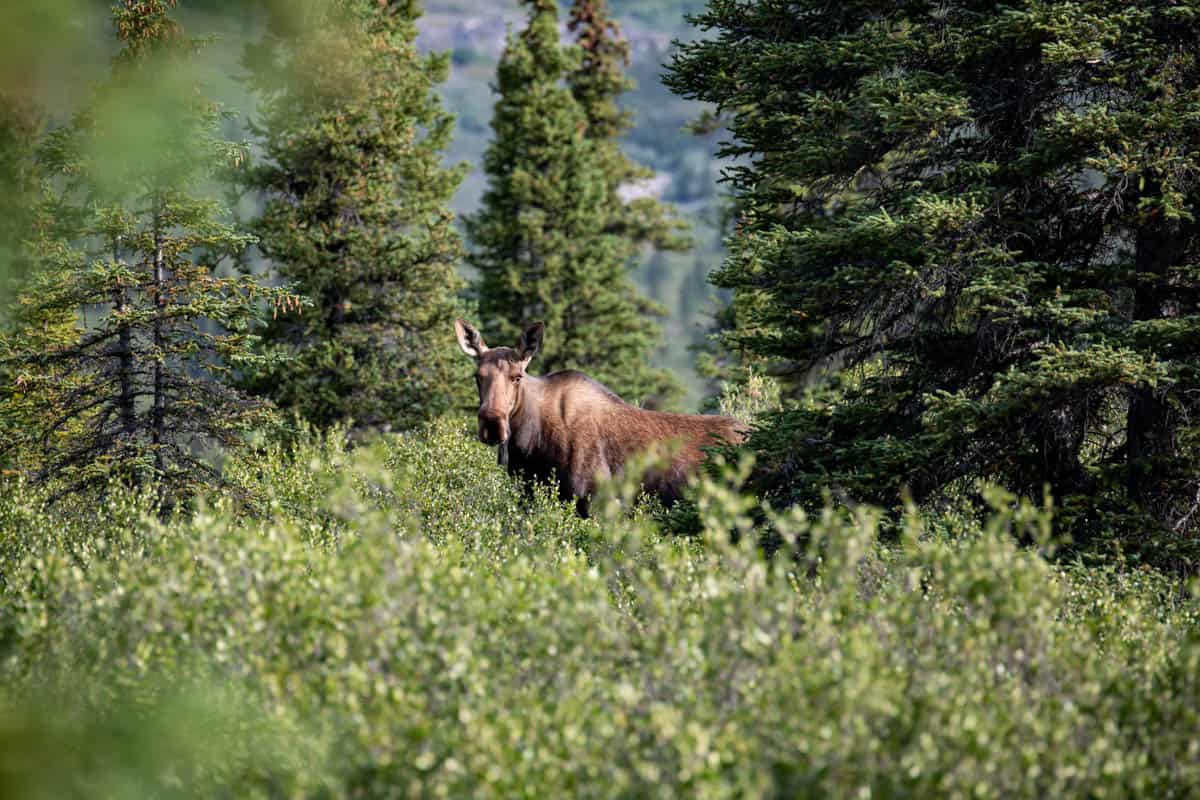
Table of Contents
- Introduction To Denali National Park
- Wildlife Viewing Opportunities
- Denali Park Road
- Will I be able to see the actual mountain?
- Denali Sled Dogs
- Hiking Trails
- Other Activities
- Tips For Visiting The Park in the Summer
- Best Time To Visit Denali National Park
- How do you get to Denali National Park?
- More Alaska Travel Posts
Introduction To Denali National Park
Alaska has 8 national parks, more than any other state except for California, so we made it a point to see as many of them as we could during our trip to the 49th state. Denali National Park was wildly beautiful, immense, and filled with things to see and do. We wish we had had more than just a couple of days in the area so we could see more!

Wildlife Viewing Opportunities
Denali has a diverse ecosystems and abundant wildlife. Alaska even has its own “Big 5” similar to Africa and all of them can be seen in Denali, if you are lucky.
We didn’t get to see all of them, but we were able to see four of the Alaska Big 5: moose, bears, Dall sheep, and caribou. The only one of the big 5 that we didn’t see on our trip was wolves, which are more elusive and far fewer than the others.
Grizzly Bears
Of course when people come to Alaska grizzly bears are at the top of their list of animals they would like to see and Denali provides good opportunities for bear sightings. These magnificent creatures roam the vast meadows, forests, and tundra of Denali National Park during the summer months, foraging for food like berries, roots, and small mammals.
Don’t expect to see them up close like we did at Lake Clark National Park though. The grizzlies at Denali are typically seen from a distance, either grazing on vegetation or wandering through their habitat. We saw two bears along the Denali Park Road while doing the Tundra Wilderness Tour and both were quite a distance from the bus, high up on a mountainside foraging around shrubs that I would guess were loaded with wild berries. You’ll want binoculars or a powerful zoom lens for your camera in order to see them better because they blend in pretty well unless they are moving as you can probably tell from the image on the right below.
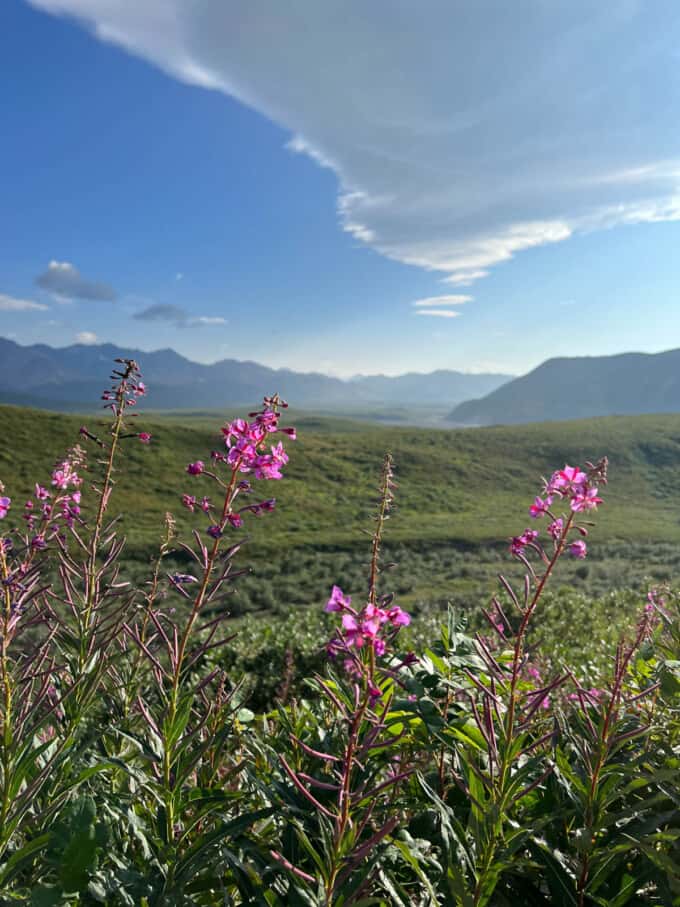
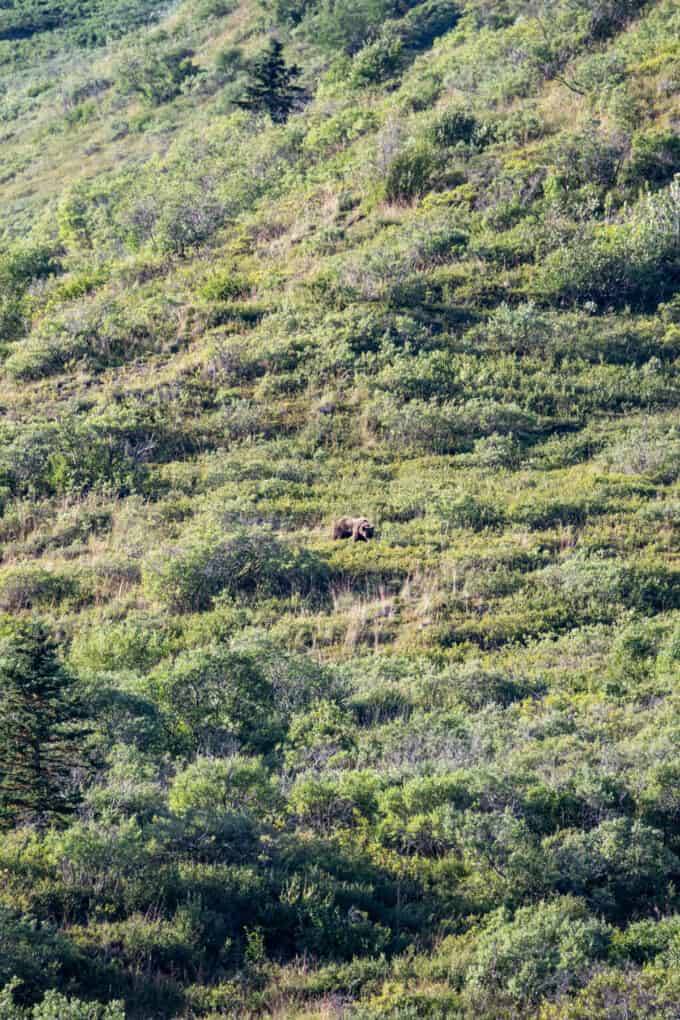
Moose
Denali is home to a thriving population of moose, which are actually the largest member of the deer family! Moose are massive herbivores and can often be spotted near rivers and lakes, where they graze on aquatic vegetation.
We saw them ambling through the forested areas chewing on shrubs and right as we were leaving the park there was one near the roundabout at the park entrance! Moose sightings are relatively common during the summer months.
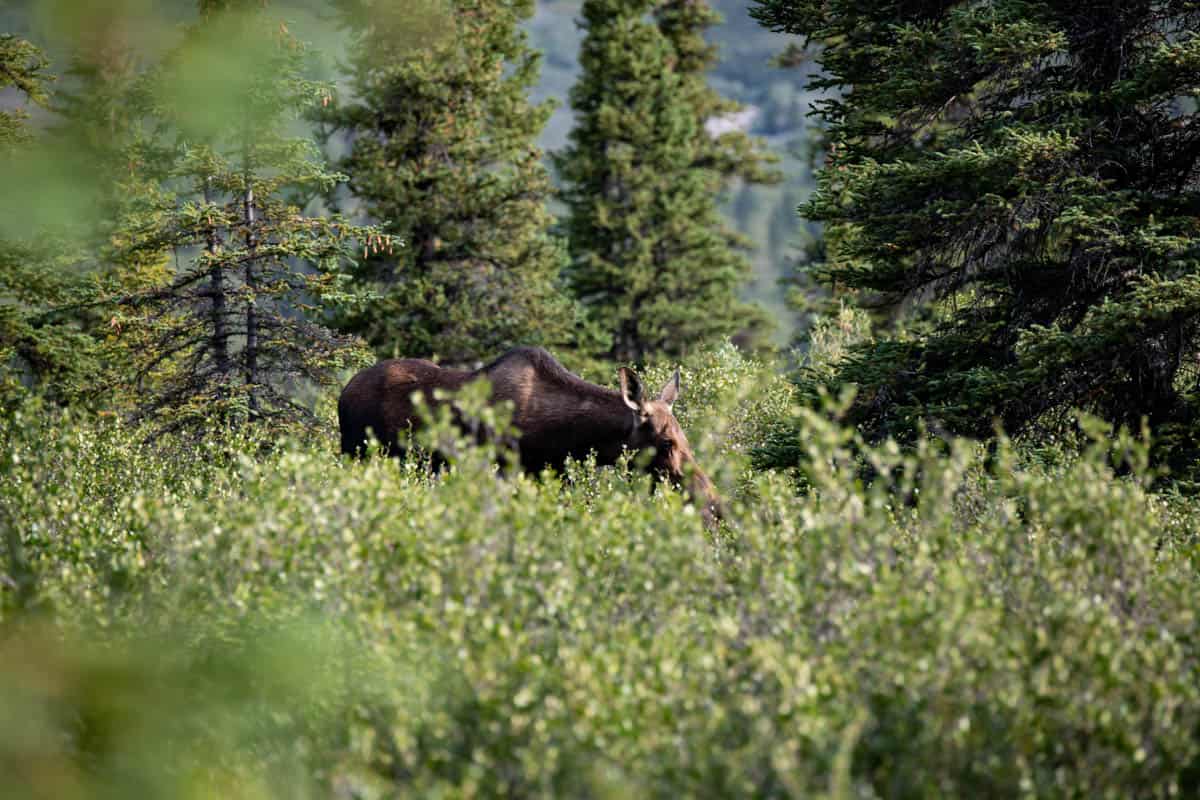
Caribou
Caribou, also known as reindeer, are another iconic species that you can see in Denali. They are migratory animals and can be seen grazing on tundra vegetation in the summer while also looking for mates. In the winter they migrate to lower elevations in search of food and shelter. We saw more caribou than any other animal while we explored the park.

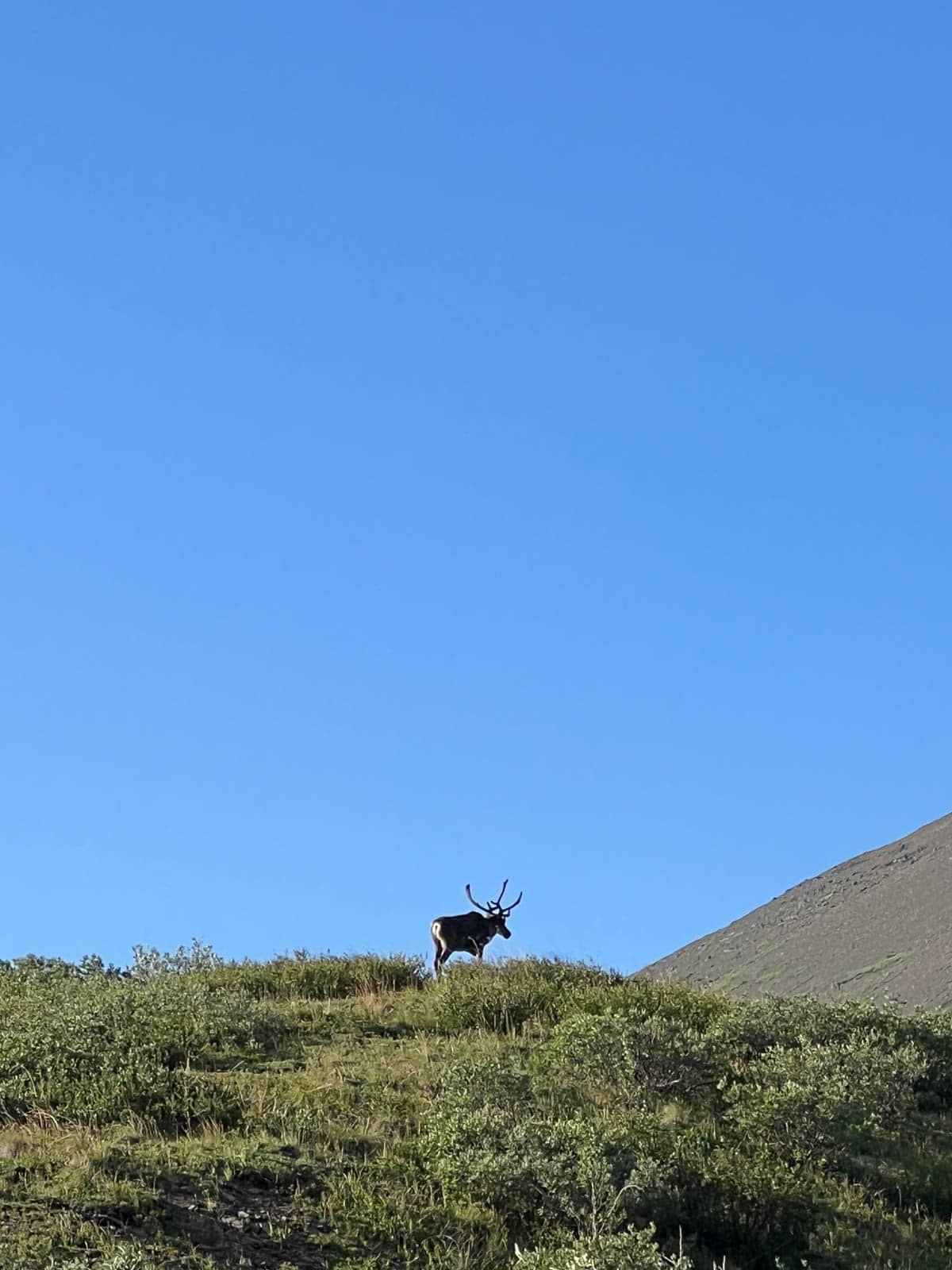
Dall Sheep
We saw a number of Dall sheep in the park, but they were some of the hardest to spot because they are usually so high up on steep, rocky terrain far from the park road. They are commonly found on cliffs, ridges, and alpine meadows, where they have access to forage and escape routes from predators, but that doesn’t make them easy to spot for humans either. Definitely have your binoculars ready and look for small white spots high up on the mountain to see them.
These large white sheep are known for their impressive curved horns, which males use to compete for dominance during the mating season. Both males (rams) and females (ewes) have horns, but the rams’ horns are larger and more curled. We were never close enough to even try to distinguish the rams from the ewes.
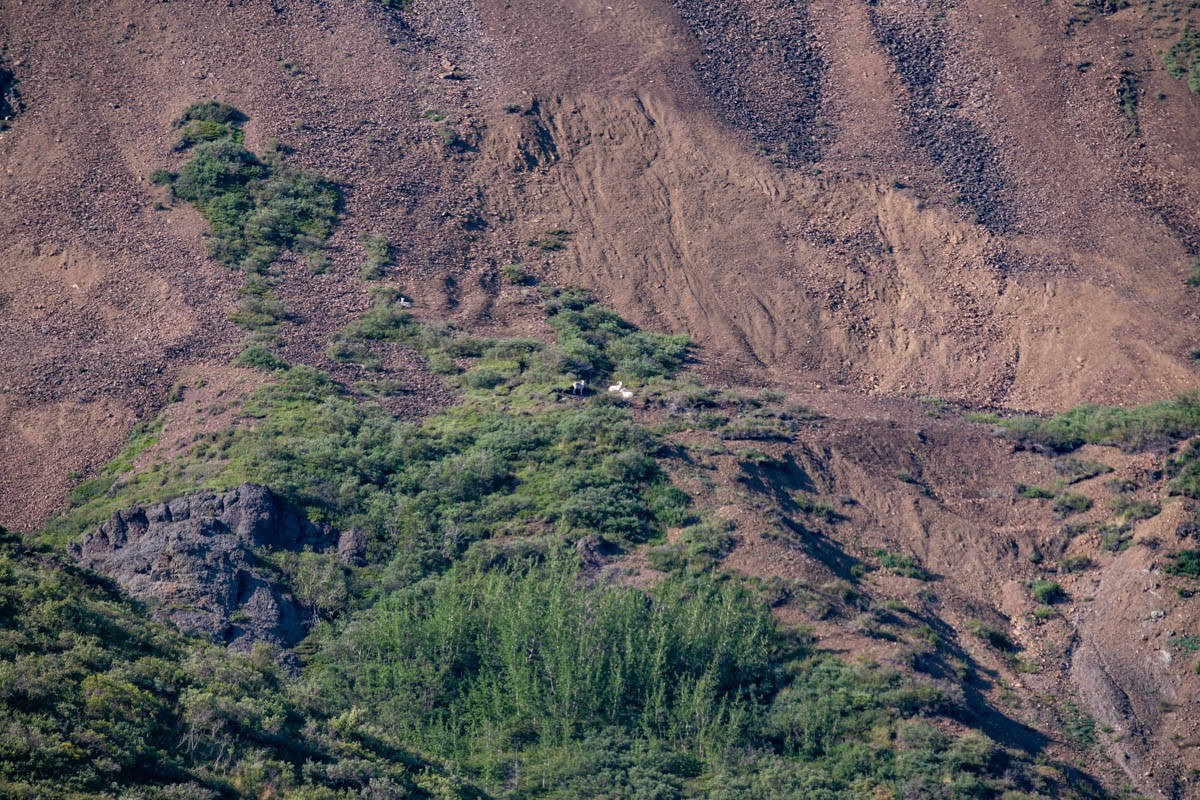
Wolves
Wolves are one of the most elusive and iconic predators in Denali National Park. Sightings are pretty rare, but the park is home to several packs of wolves that roam its vast wilderness.
Other Denali Wildlife
While the Big 5 get most of the attention, Denali National Park is home to a diverse array of wildlife, including foxes, lynx, beavers, Arctic ground squirrels, ptarmigan, and a variety of bird species. I can tell you that our kids were just as excited to watch this momma arctic ground squirrel chirping at us from the side of the trail as there were to gaze through binoculars at a bear or moose.
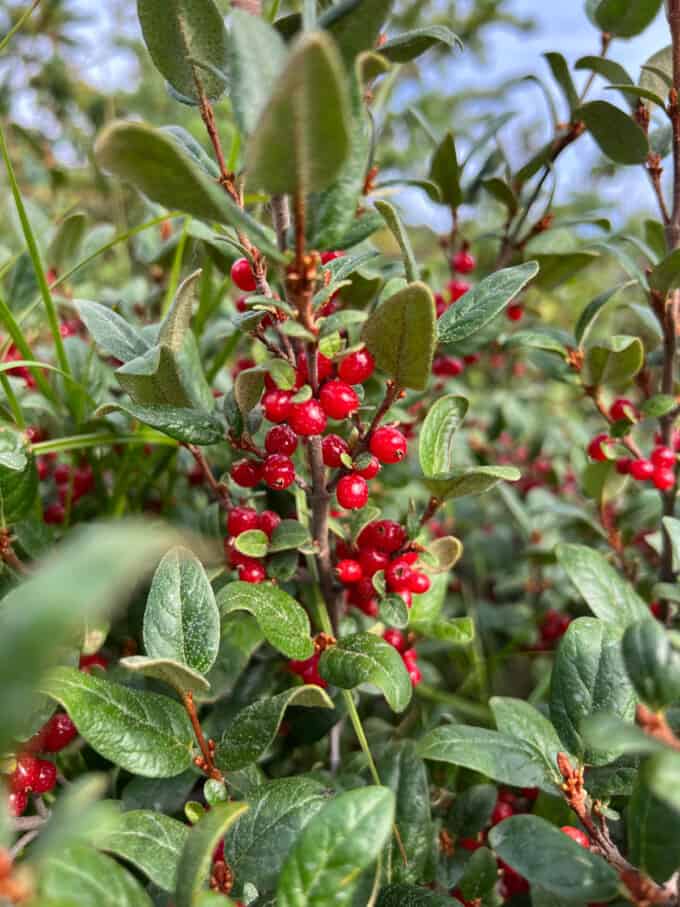
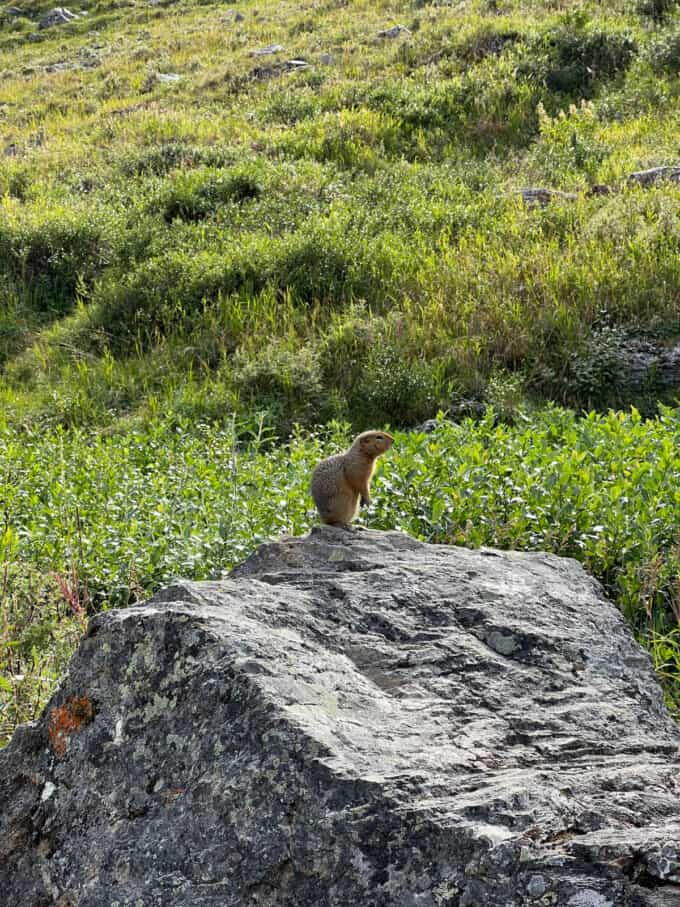
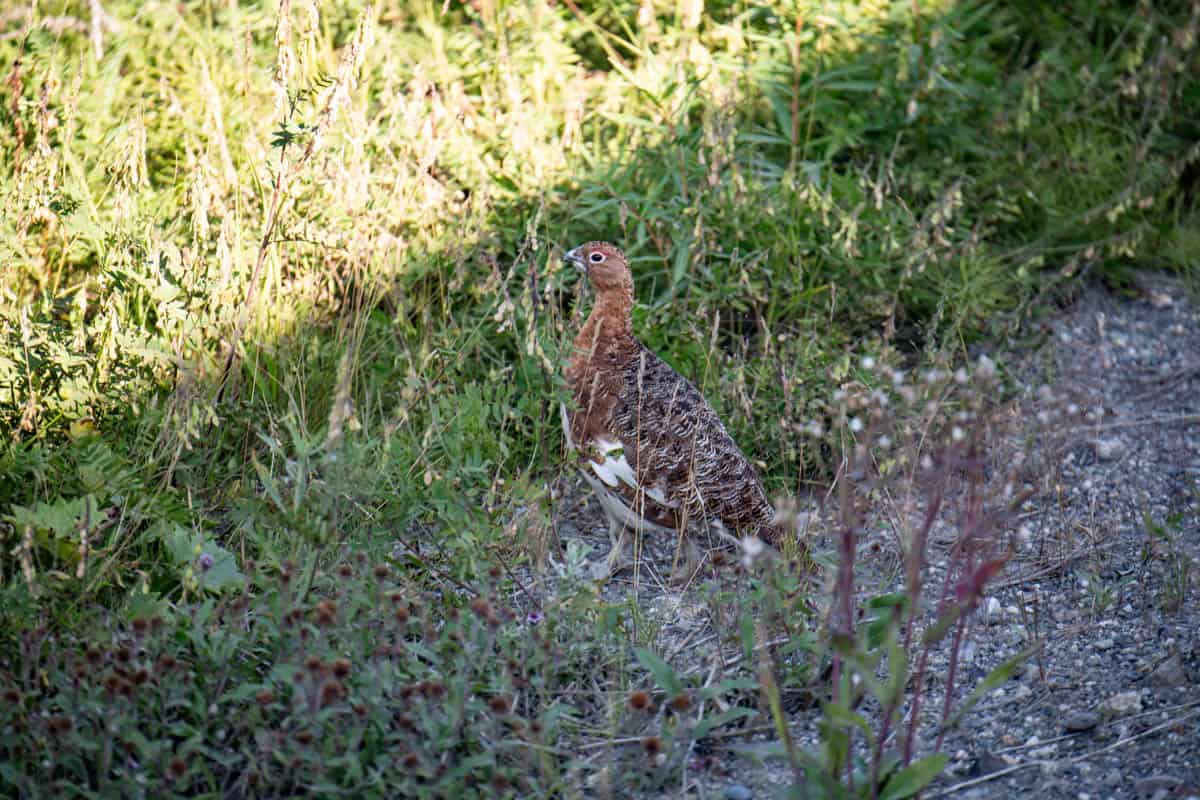
Denali Park Road
The famous Denali Park Road winds its way through Denali National Park and Preserve in Alaska. It stretches for approximately 92 miles through the heart of Denali National Park beginning near the park entrance and following a mostly east-west route deep into the wilderness and is the primary means for visitors to explore the interior of Denali National Park.
The Denali Park Road offers breathtaking views of the Alaska Range, including the iconic peak of Denali (formerly known as Mount McKinley), North America’s highest mountain. Along the route, you can enjoy sweeping vistas of mountains, tundra, boreal forests, and meandering rivers.
Private vehicles are only allowed to travel the first 15 miles of the road. Beyond that point, access is restricted to buses operated by the National Park Service (NPS).
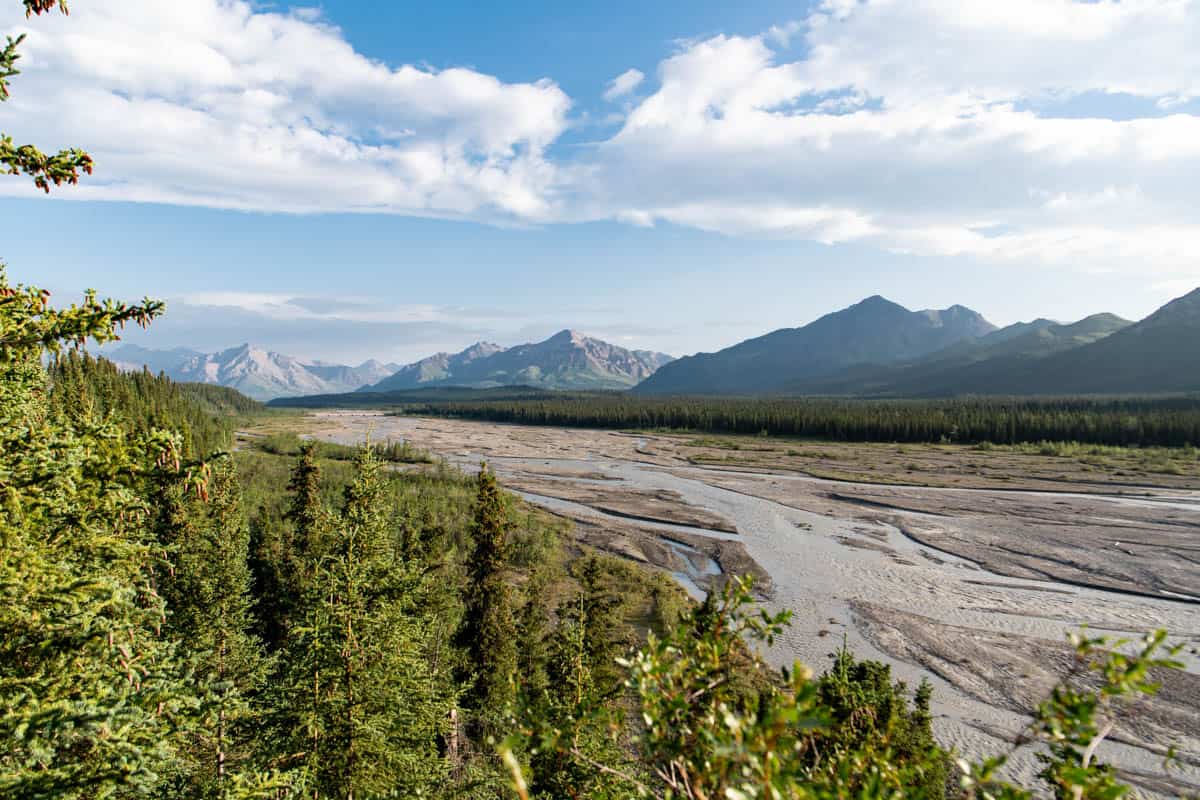
Tundra Wilderness Tour
The Tundra Wilderness Tour is a popular bus tour offered by the National Park Service. It follows the Denali Park Road, venturing deep into the heart of Denali’s wilderness.
There was a landslide in 2021 that damaged the road, so now the buses have to turn around at the midway point at Mile 43 instead of going as far as they used to. It’s not expected to be reopened until 2026.
The tour is narrated by driver-naturalists who provide insights into Denali’s natural and cultural history, as well as information about the park’s wildlife, geology, and ecology. They are great about sharing interesting facts and stories, and we were encouraged to ask questions along the way.

The tour typically lasts around 7 to 8 hours, including travel time and stops along the way. The length of the tour allows ample opportunity for wildlife viewing, photography, and experiencing the park’s diverse landscapes. A snack is included with the price of the tour, but it’s such a long day that I highly recommend bringing more to eat and extra waters with you in a backpack. Many of the lodges and other accommodations in the area offer a boxed lunch that you can pick up ahead of time for your trip.
The tour includes several designated rest stops and viewpoints where passengers can stretch their legs, use restroom facilities, and take in panoramic views of the surrounding landscapes.
Do I need a reservation?
I definitely recommend getting a reservation as early as you can if you are coming during peak summer season when demand is high. Tickets can be purchased in advance through the NPS reservation system or at the Denali Visitor Center. The tours departures are staggered to try to accommodate as many visitors as possible, but they definitely sell out.

Will I be able to see the actual mountain?
Seeing Denali, formerly known as Mount McKinley, is not a guarantee since it is often shrouded in clouds, especially during the summer months. You can try to plan your visit during periods of clear weather, typically in the early morning or late evening when visibility tends to be better, but the weather is highly unpredictable in Alaska so that doesn’t always work out.
Remember that visibility of Denali can vary from day to day, and even hour to hour, so if you can be flexible with your plans you will have the best luck of getting a glimpse of the mountain. Keep in mind that Denali’s summit is often covered in clouds, but even partial views of the mountain can be breathtaking and memorable.
We were very lucky and had one really nice day when Denali was visible, but even then it was hazy and the mountain is actually pretty far away so it was a little difficult to make out. Still, we felt very fortunate to see it!
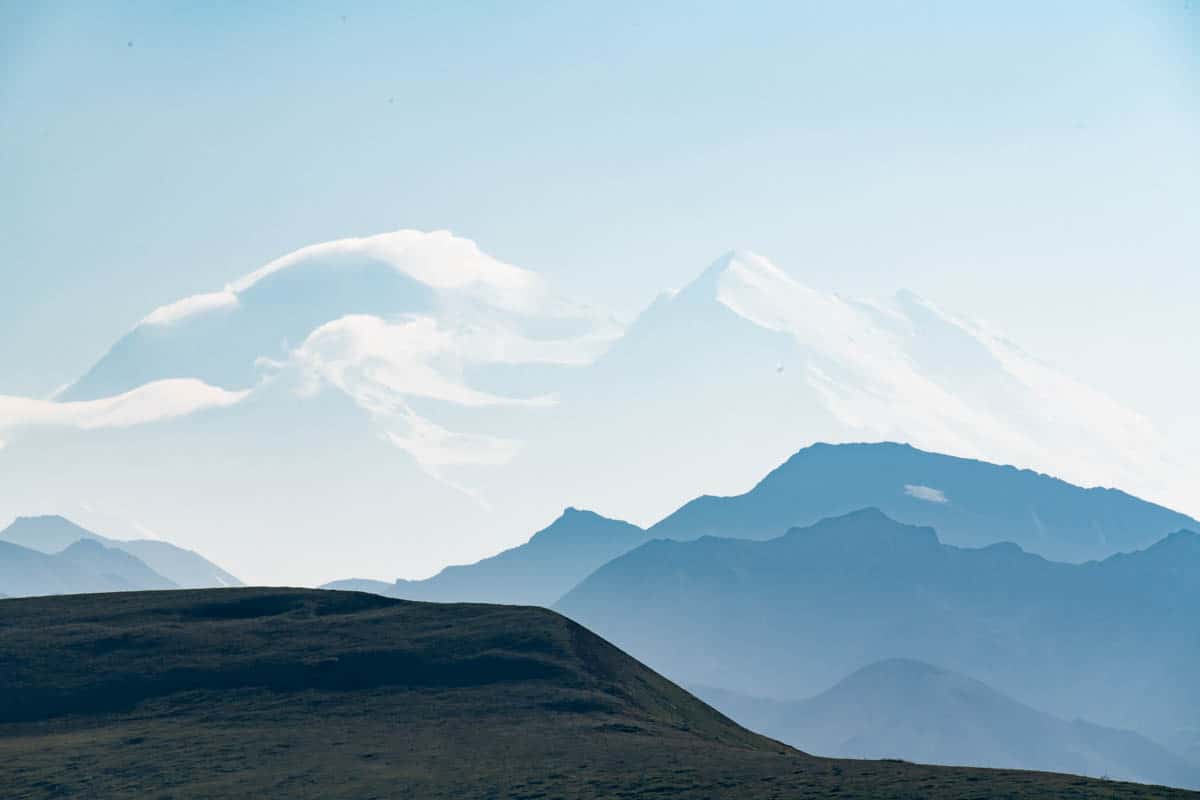
Flightseeing at Denali
If you REALLY want to see the mountain and it is within your budget, consider taking a flightseeing tour for a bird’s-eye view of Denali and the surrounding Alaska Range. Flightseeing tours depart from nearby communities such as Talkeetna and offer breathtaking aerial perspectives of the mountain, glaciers, and wilderness. We knew we were flightseeing in other parts of Alaska so we decided not to do it here, but next time we go back I’m definitely adding it to the itinerary.
Backcountry Hiking
For experienced hikers who want a more remote experience, you could consider hiking or backpacking in the backcountry of Denali National Park. Some remote areas offer stunning views of Denali and the Alaska Range, away from the crowds of the park entrance area.
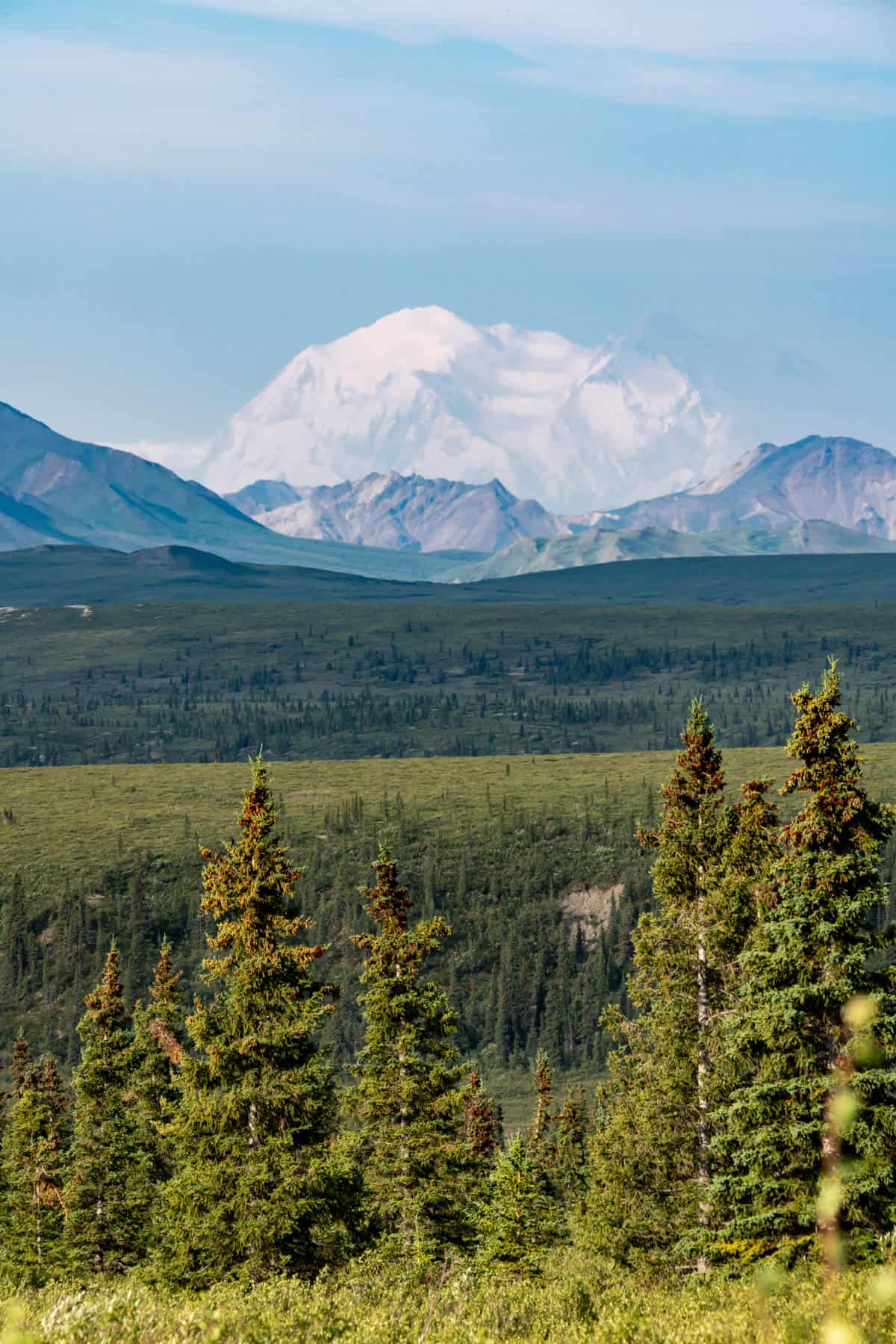
Denali Sled Dogs
The absolute highlight of our Denali visit for our kids was visiting the Denali Sled Dog Kennels. We didn’t know before we went that Denali has actual working sled dogs that play a crucial role in winter transportation, patrolling, and search and rescue operations within the park. These sled dogs help rangers access remote areas of the park that are often inaccessible by other means during the winter months.
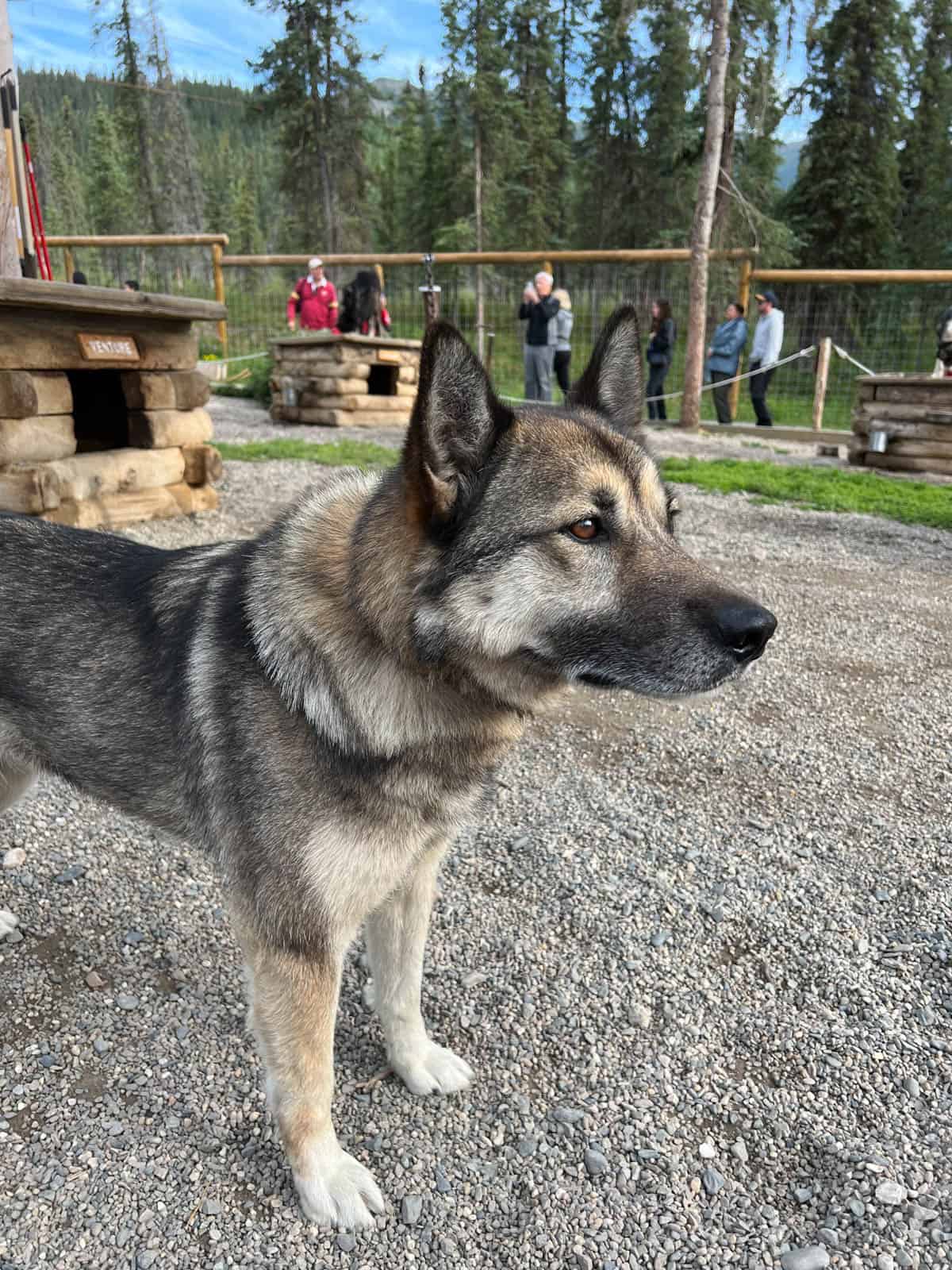
The Denali Sled Dog Kennels offer visitors a unique opportunity to learn about the history, culture, and importance of sled dogs in Alaska. There are ranger-led programs and demonstrations where you can meet the sled dogs, interact with park rangers, and learn about the training and care of the dogs.
Our girls loved learning each of the dogs names (Cupcake was a particular favorite) and sketching them in their Jr. Ranger booklets.
PRO TIP: The red backpack Rose is wearing below was actually a Denali Discovery Pack that is provided for free at the Visitor Center which you can check out for kids to use while in the park and return before you leave. It was loaded with all kinds of stuff from colored pencils to a compass, ruler, activity guide, pH test kit, books and more. It was awesome and something we have never seen in our many visitors to other national parks.
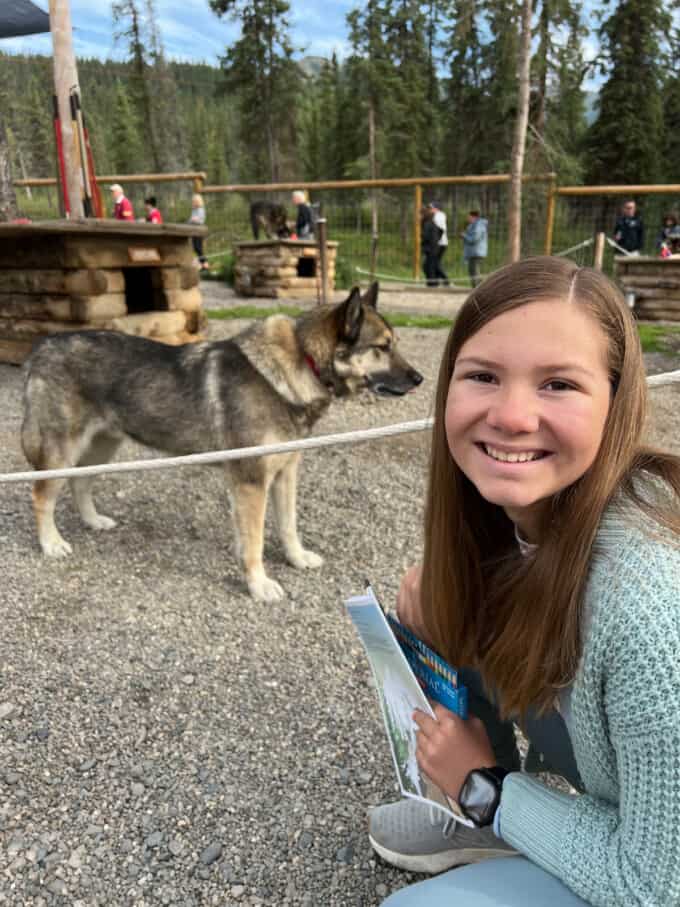
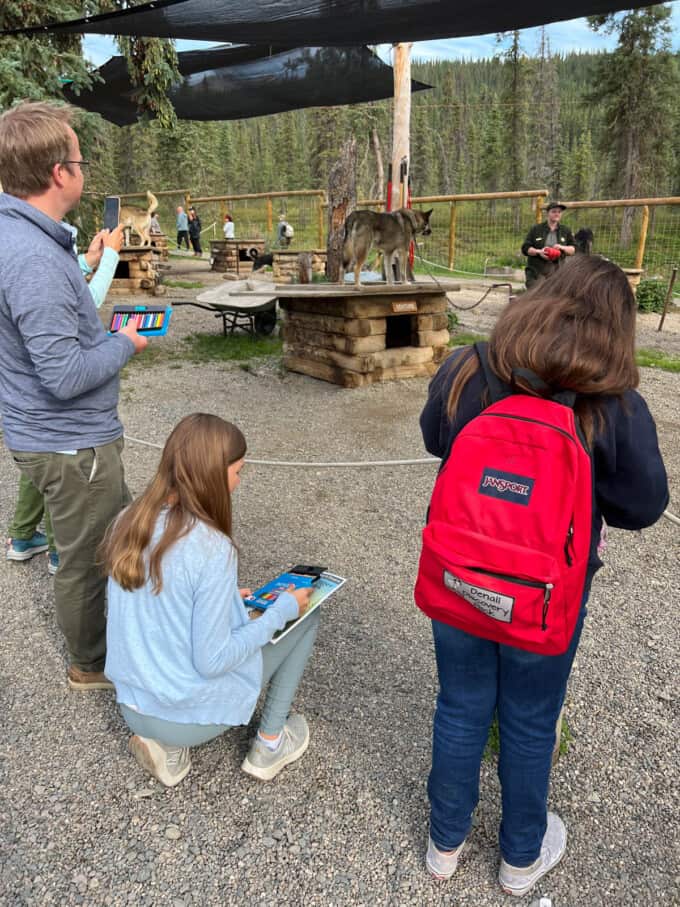
If the weather isn’t too warm, they will even harness the dogs up and do a short loop with a special sled on wheels to show off the dogs, although we were informed that often they don’t do this part of the presentation later in the day when it warms up, so you might want to consider going to the first exhibit in the morning if that’s something you are interested in.
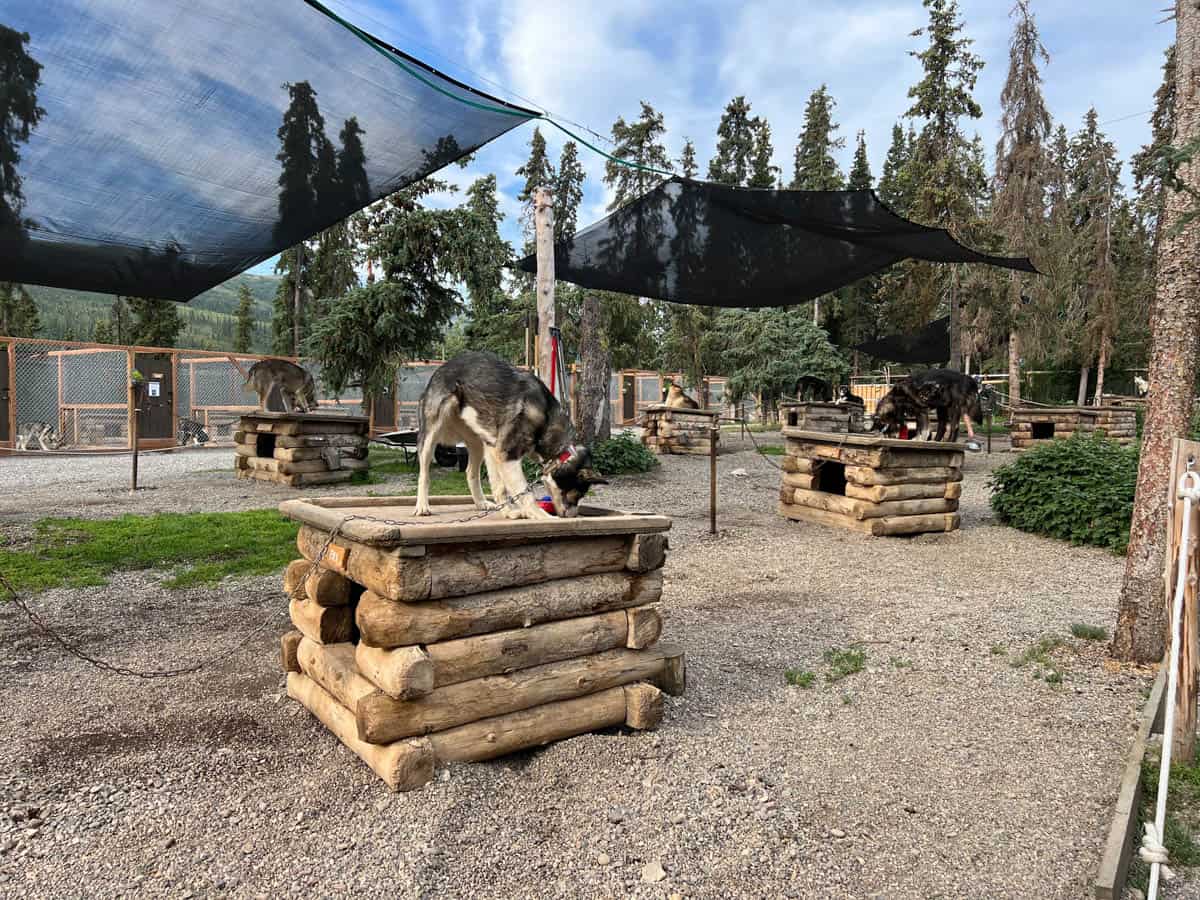
Sled dogs have a rich history in Denali National Park, dating back to the early days of exploration and mountaineering in the region. The park’s sled dogs are descendants of the original sled dog teams that were used for transportation and hauling supplies in the early 20th century and at the kennels you can see them up close and learn about them from rangers who care for them.
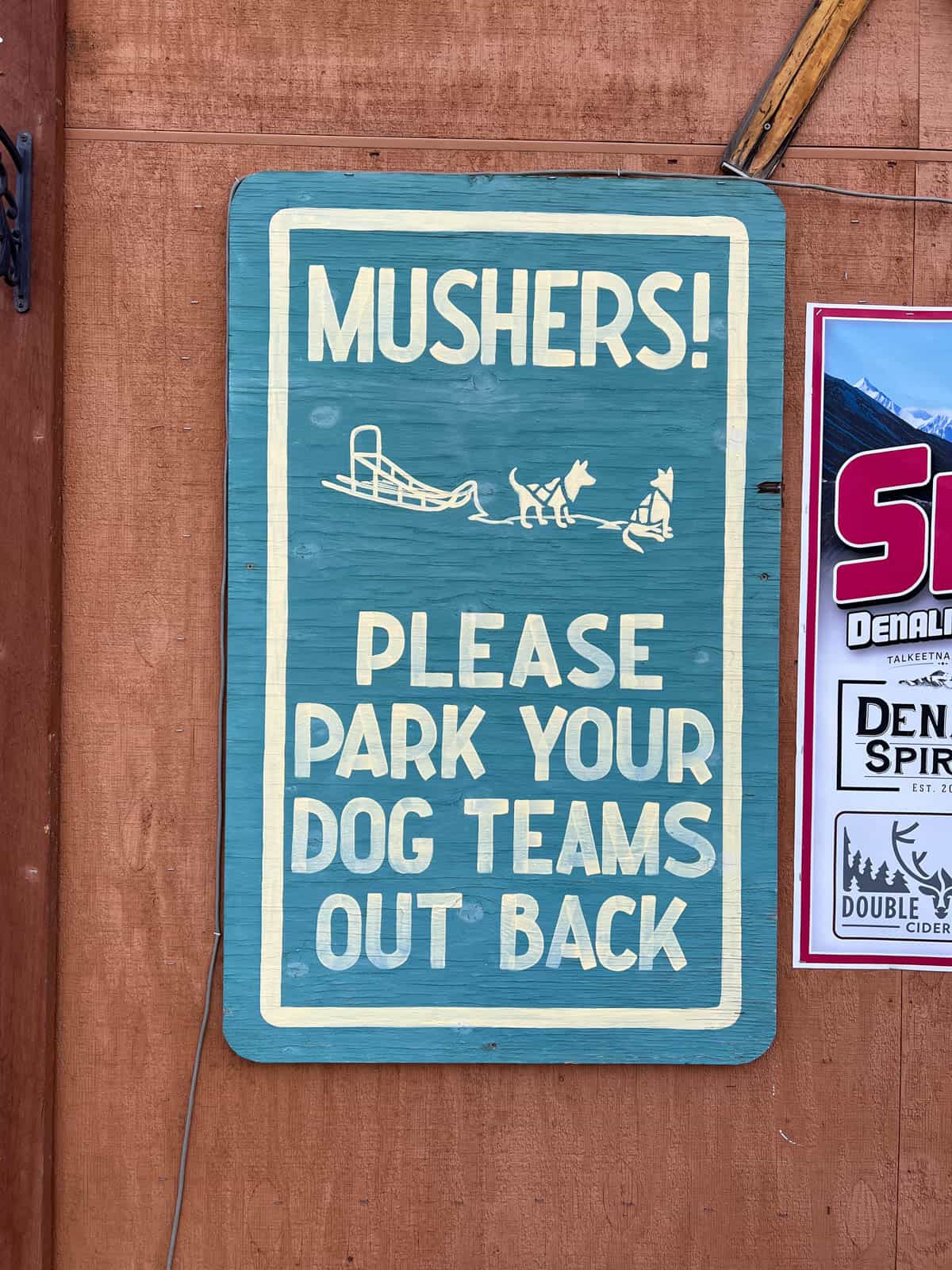
Hiking Trails
There are many hiking trails through the expansive area covered by Denali National Park and Preserve, but here are some of the most popular:
Savage Alpine Trail (Challenging)
The Savage Alpine Trail is in the Savage River area, near the park entrance. The trailhead is easily accessible from the Savage River Loop Road, which is a scenic drive offering views of the surrounding mountains and tundra and can be reached by private vehicle.
The Savage Alpine Trail is about 4 miles long one way, making for an 8-mile round-trip hike. The trail is considered moderately difficult, with sections of steep elevation gain and uneven terrain. It’s not one our girls would have been thrilled to do with us. Despite our best efforts, they still have yet to embrace a love of hiking like their parents.
This trail is supposed to offer stunning panoramic views of the Alaska Range, including Denali, on good weather days. The scenery is supposed to be particularly spectacular during the summer months when the tundra is in bloom and you will see rugged mountains, winding rivers, and alpine meadows dotted with wildflowers.
Keep in mind that snow and ice may linger on the trail into early summer, so be prepared and check trail conditions before setting out. Also, mosquitoes can be prevalent in the area during the summer months, so you might want to bring insect repellent too. And always carry bear spray, just in case.
Savage River (Easy)
We opted for the easier Savage River Trail with our kids and had a great experience. The Savage River Trail is also located near the entrance area of Denali National Park, accessible from the Savage River Loop Road. The trailhead is about 15 miles from the park entrance, making it easily accessible for visitors exploring the park and you can either take a shuttle to the trailhead or drive your own vehicle there, although parking is limited.
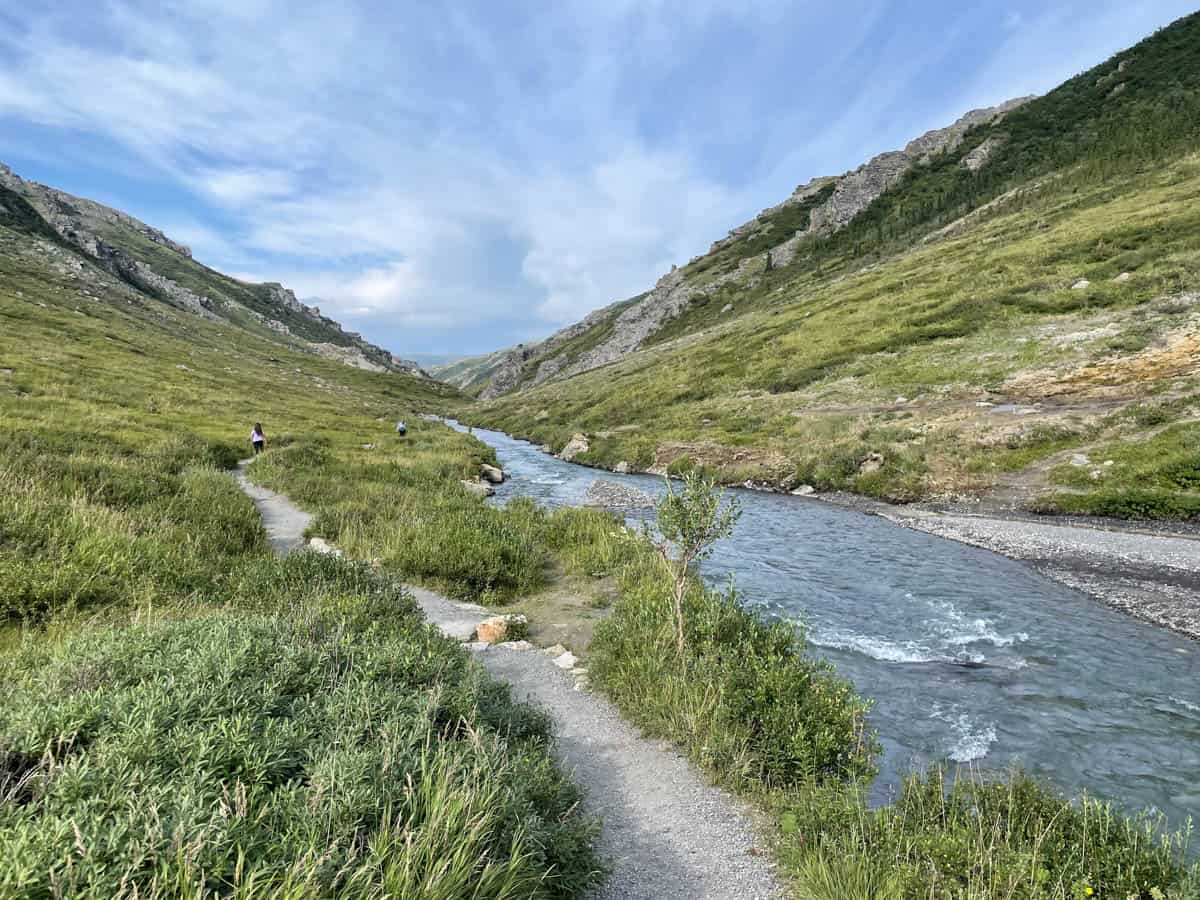
This trail is a relatively short 2 mile loop and is rated as an easy to moderate hike, suitable for hikers of all skill levels and ages. There is minimal elevation gain and well-maintained paths, so it is a popular choice for families and casual hikers.
You can still expect beautiful views of the surrounding landscape, including the Savage River Valley, the Alaska Range, and nearby mountains. The scenery is supposed to be particularly stunning during the fall when the tundra foliage turns red and gold.
Hikers on the Savage River Trail may encounter a variety of animals, including Dall sheep, caribou, moose, ptarmigan, Arctic ground squirrels, and other bird species.
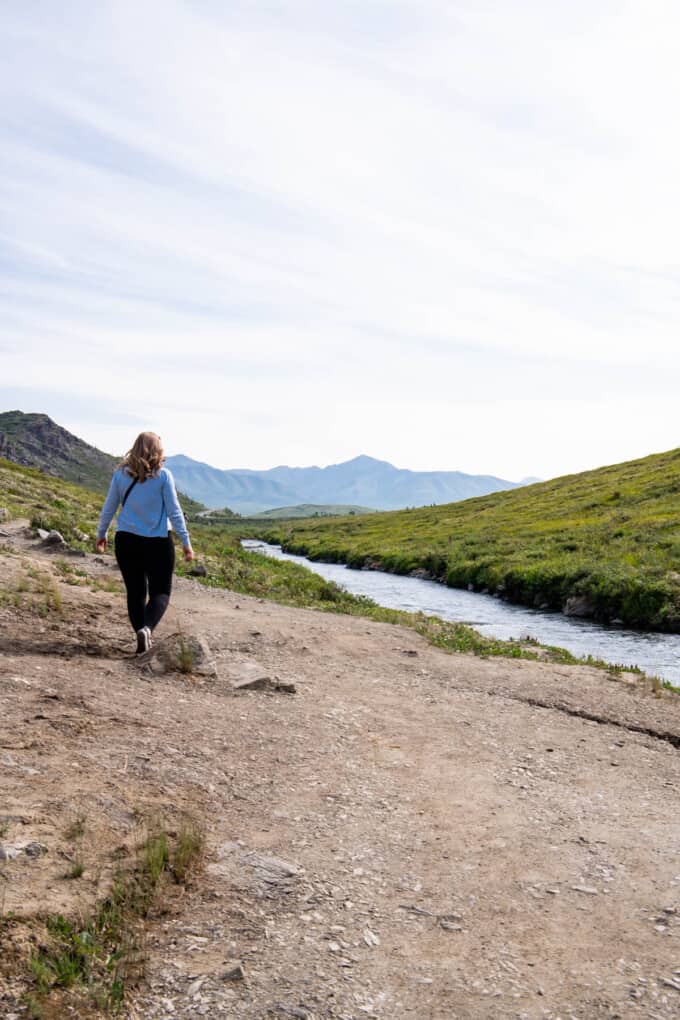
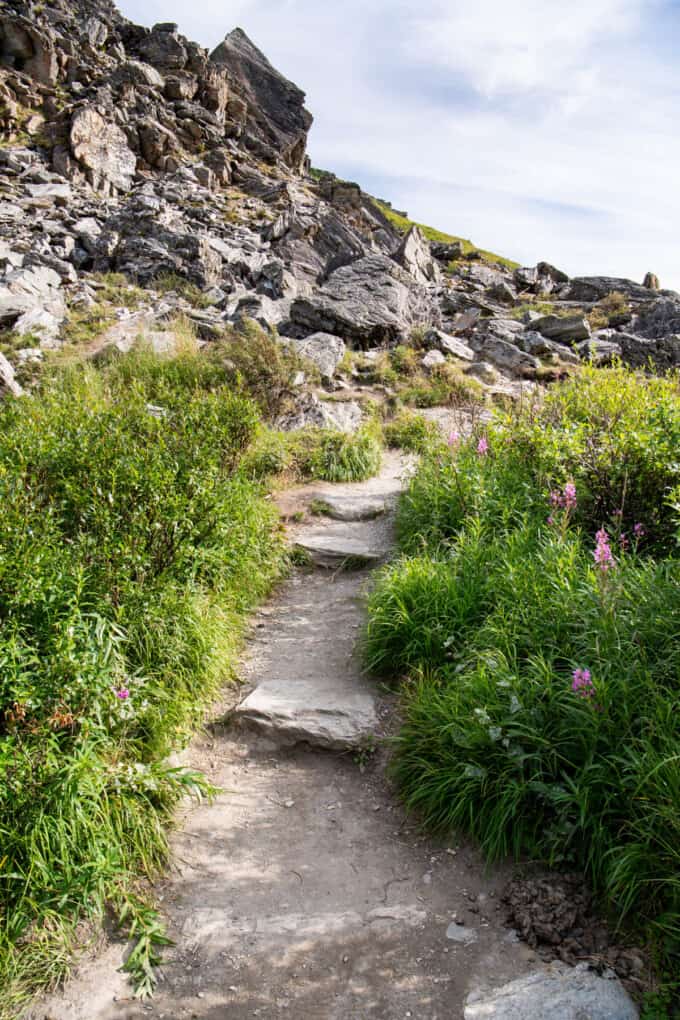
The Savage River Trailhead has parking facilities, restrooms, and picnic areas for visitors as well as benches and interpretive displays at various points along the trail, providing opportunities to rest and learn about the park’s natural and cultural resources. It’s an excellent option for those looking for a shorter hike with stunning views and educational opportunities.
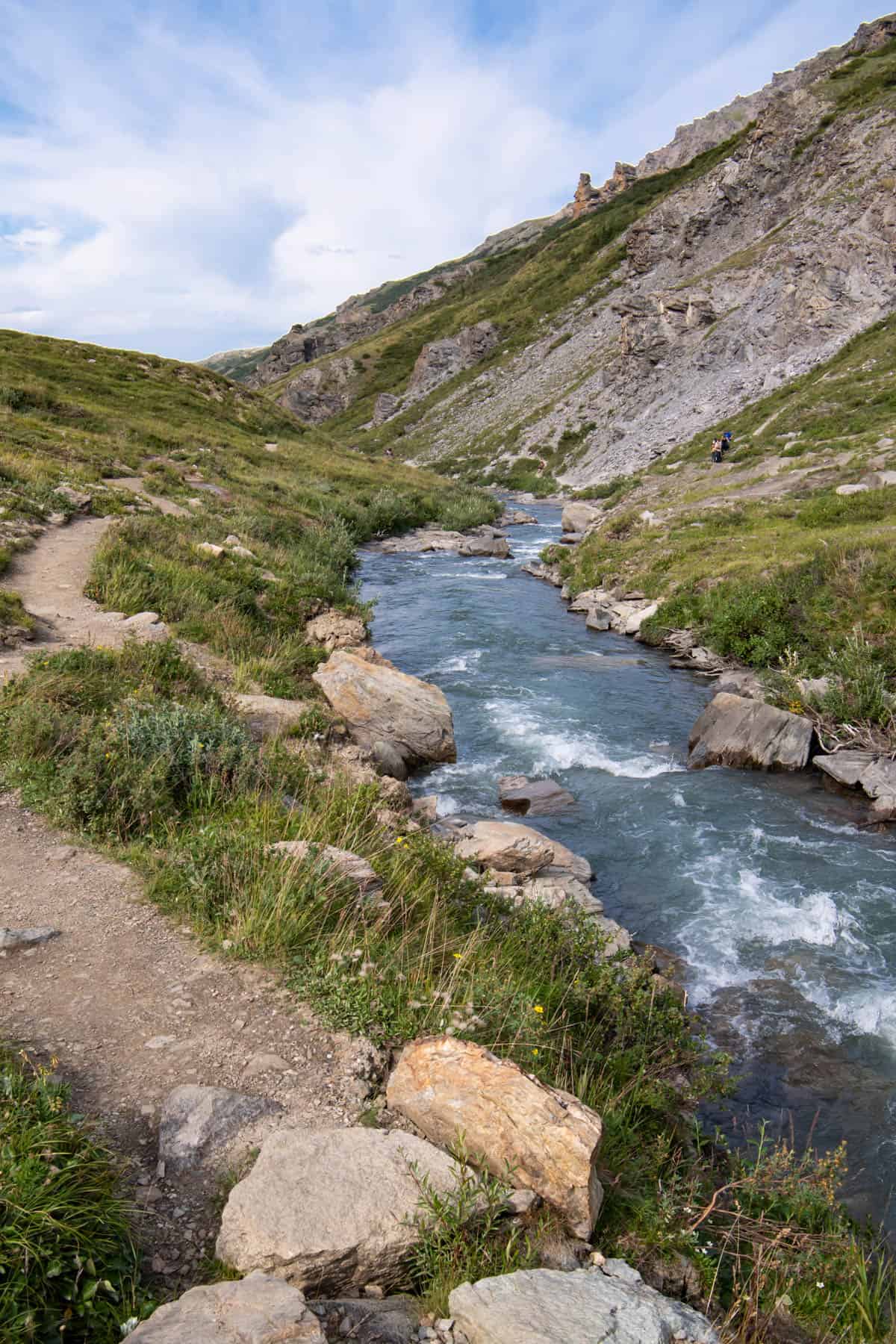
McKinley Station Trail (Easy)
The McKinley Station Trail is one of the shorter trails in Denali National Park, and is also only 2 miles round trip like the Savage River Loop Trail. It begins near the park’s entrance area, close to the visitor center, making it easily accessible for visitors.
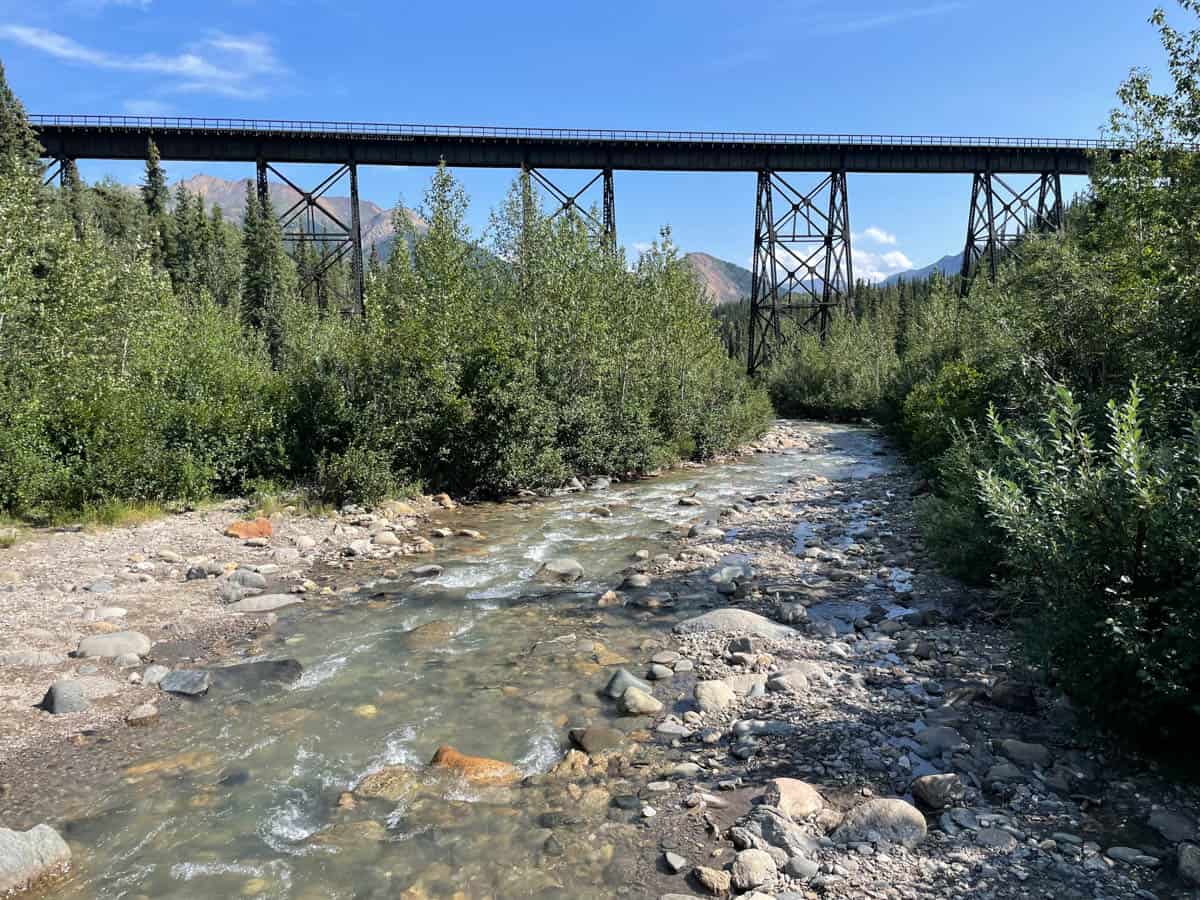
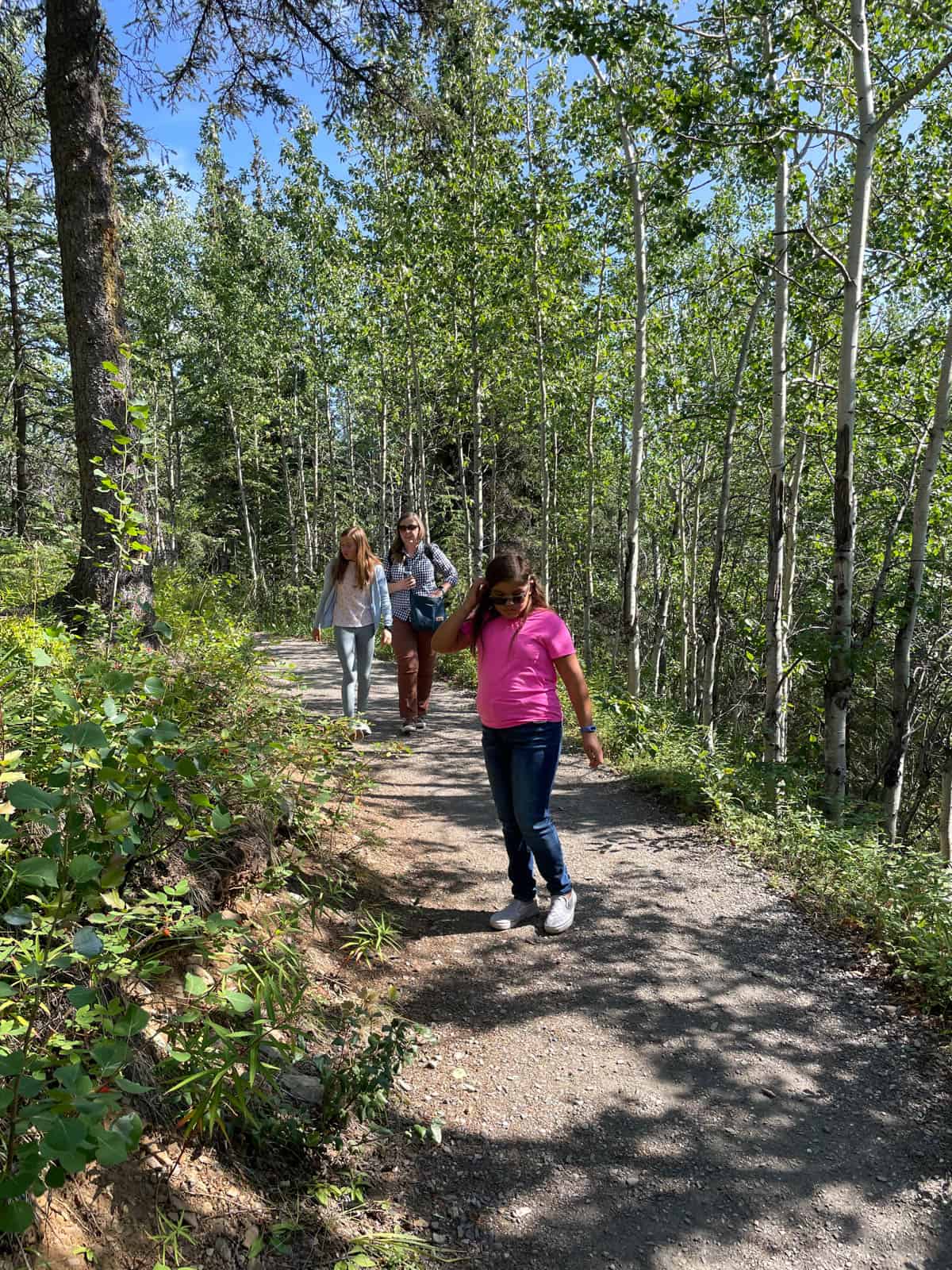
What makes the McKinley Station Trail unique and fun (especially for kids) are the suspension bridges that hikers encounter along the route. These bridges sway and bounce with the movement of hikers as they cross over the Riley Creek and Hines Creek, providing an exciting and slightly adventurous element to the hike.
The suspension bridges offer thrilling views of the water below and the surrounding landscape, adding to the overall experience of exploring the park that we loved. You might even get lucky and see a moose here!
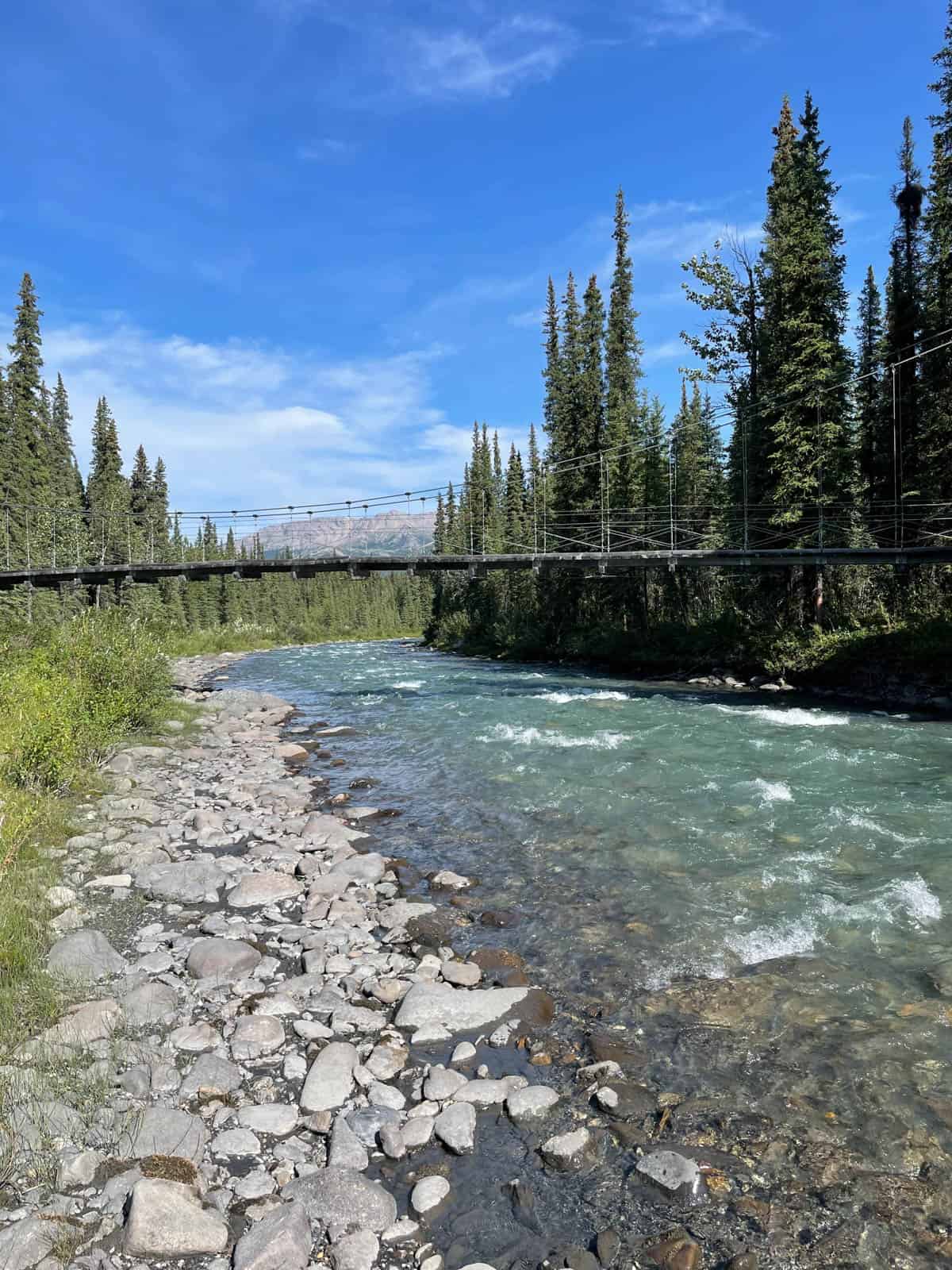
Other Activities
Denali Jr. Ranger Program
Our kids did the Jr. Ranger program at Denali and it was a fun way to learn a lot more about this vast wilderness area. It made the whole experience even more memorable and meaningful for them and us. We spent time in the visitor center learning from the many exhibits about the history of Denali, the people who have spent their lives there, and the animals and plants that are abundant in Denali National Park.
Ranger Led Programs
Denali National Park and Preserve offers a variety of ranger-led programs that aim to provide opportunities to learn about the park’s natural and cultural resources.
Guided hikes are popular as rangers lead interpretive hikes along designated trails, providing insights into the park’s natural history, wildlife, and ecosystems. These hikes vary in length and difficulty, catering to different interests and fitness levels.
There are also campfire programs where you can gather around a campfire with a ranger for an evening of storytelling, educational presentations, and discussions on topics such as wildlife, wilderness conservation, and the cultural history of Denali.
Tips For Visiting The Park in the Summer
- Plan and Book in Advance: Denali is a popular destination for an Alaska summer vacation, so try to plan your trip well in advance, especially if you’re booking accommodations, transportation, or tours. Campground and lodging reservations often fill up quickly, so book early to secure your preferred dates.
- Pack Layers: Summer weather in Denali, like all of Alaska, can be unpredictable, with temperature fluctuations and occasional rain. Pack layers of clothing that can be easily added or removed to adapt to changing conditions. We definitely made good use of our rain jackets, hats, and sturdy hiking shoes.
- Bring Bear Spray and Practice Bear Safety: Denali is home to grizzlies and black bears. Be prepared for bear encounters by carrying bear spray and knowing how to use it properly. Make noise while hiking to alert bears of your presence, and familiarize yourself with park guidelines for bear safety.
- Take Advantage of Shuttle Buses: Private vehicles are only allowed on the first 15 miles of the Denali Park Road. Beyond that point, access is restricted to shuttle buses operated by the National Park Service. Use the shuttle buses to access remote areas of the park, enjoy scenic viewpoints, and increase your chances of wildlife sightings.
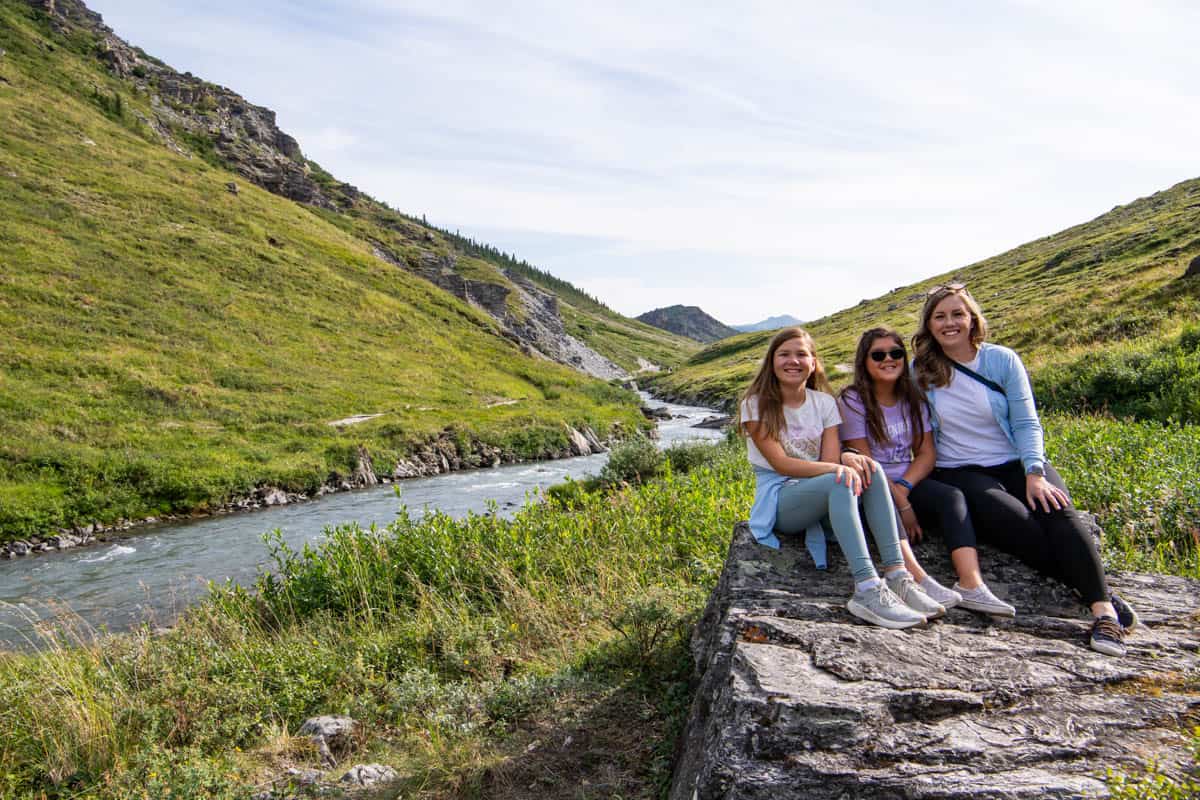
Best Time To Visit Denali National Park
The best time to visit Denali National Park largely depends on what you hope to experience during your visit. We loved visiting in the summer (early August) but would love to see Denali in the fall sometime too.
Summer (June to August):
Pros: Summer is the peak tourist season in Denali, offering the most extended daylight hours and milder temperatures. It is also the best time for hiking, wildlife viewing, and taking advantage of ranger-led programs and guided tours. Plus, the Denali Park Road is open to shuttle buses, providing access to various points within the park and offering opportunities for scenic drives and wildlife sightings that might not be as easily available during other times of the year.
Cons: Keep in mind that summer can also be the busiest time in the park, with more crowds and higher accommodation prices.
Fall (September to October):
Pros: Fall offers beautiful autumn foliage and fewer crowds compared to summer. Wildlife viewing can be excellent as animals prepare for winter, and the changing colors of the tundra create stunning landscapes.
Cons: The weather can be cooler and more variable in the fall, so be prepared for colder temperatures and potential snowfall.
Spring (May to June):
Pros: Spring is a transitional period in Denali, with melting snow and increasing daylight hours. Wildlife starts becoming more active, and migratory birds return to the area.
Cons: Some hiking trails may still be snow-covered or muddy in the early spring.
Winter (November to April):
Pros: Winter offers a unique and quieter experience in Denali, with snow-covered landscapes and opportunities for winter activities such as cross-country skiing, snowshoeing, and aurora viewing. Winter is an excellent time for experiencing the solitude and tranquility of the park’s wilderness, away from the crowds of the summer months.
Cons: The park road is closed to vehicle traffic beyond a certain point, but guided tours on snowcoaches or snowmobiles are available for exploring the park’s winter wonderland.
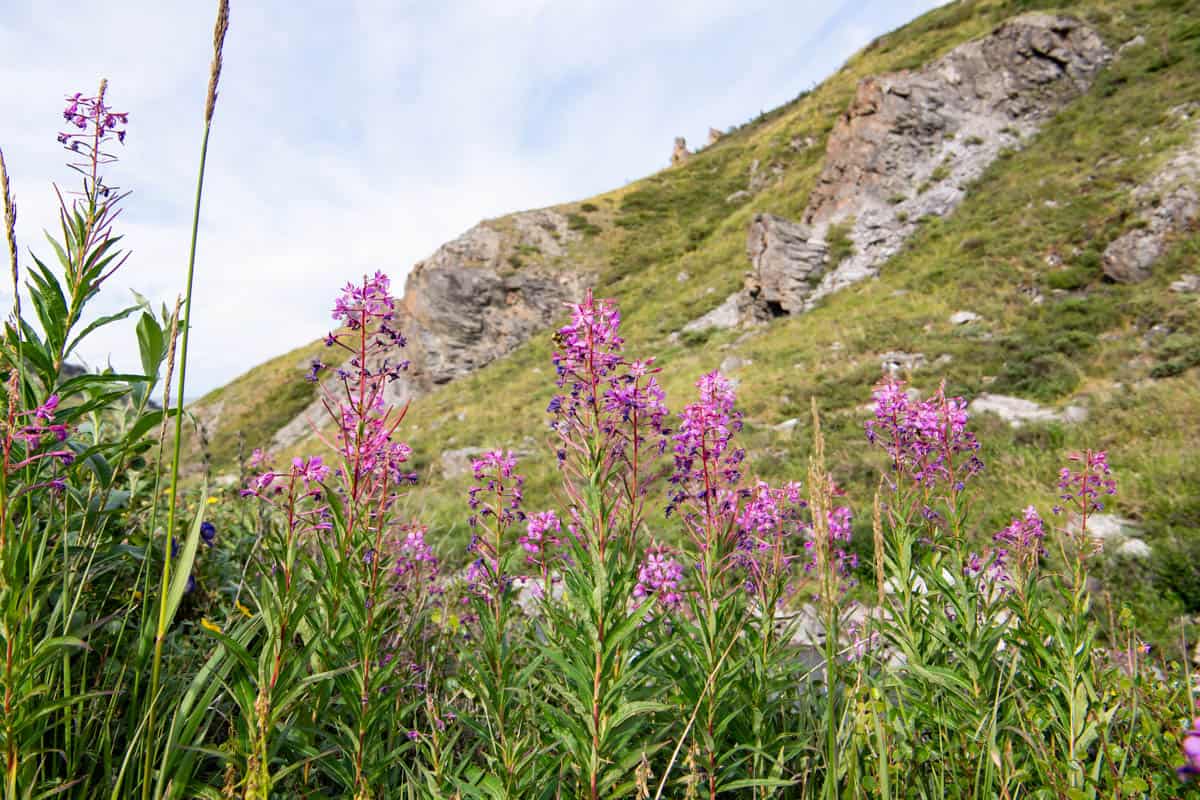
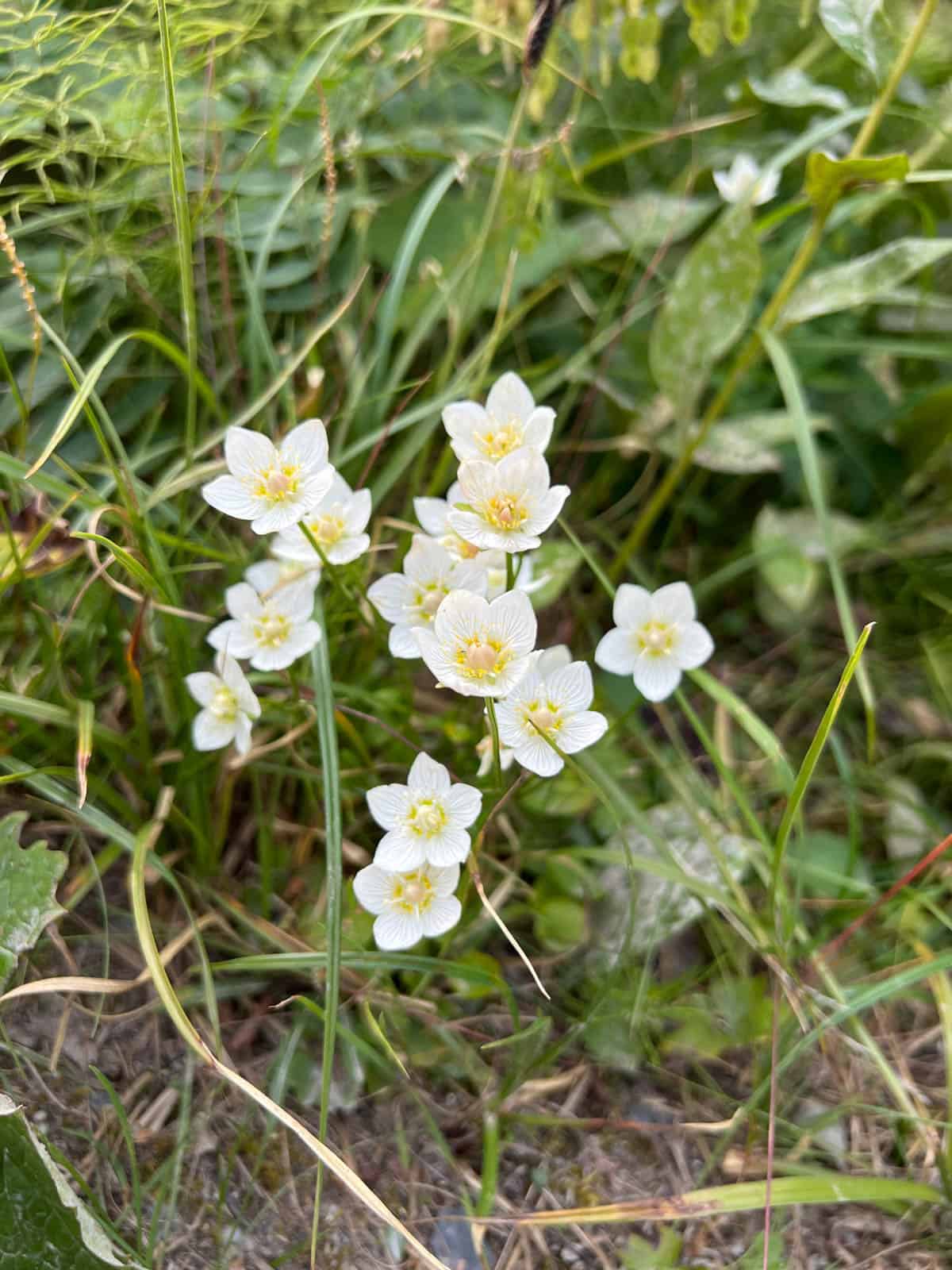
How do you get to Denali National Park?
Denali National Park and Preserve is located in the interior of Alaska, and getting there typically involves a combination of transportation modes.
Fly into Anchorage or Fairbanks
Anchorage and Fairbanks are the two largest cities in Alaska and serve as major transportation hubs. Most visitors to Denali National Park arrive by flying into one of these cities. Both Anchorage and Fairbanks have international airports with connections to major cities in the United States and beyond.
Rent a Car
Once you arrive in Anchorage or Fairbanks, you can rent a car to drive to Denali National Park. The park entrance is located approximately 240 miles north of Anchorage and 120 miles south of Fairbanks. The drive takes about 4-5 hours from Anchorage and 2-3 hours from Fairbanks but it is beautiful and a great way to experience Alaska. If you enjoy a good road trip, we can’t recommend this approach enough.
Take the Train
The Alaska Railroad offers scenic train service between Anchorage and Fairbanks, with a stop near the entrance of Denali National Park. The Denali Star train operates daily during the summer season, offering passengers the opportunity to enjoy breathtaking views of the Alaska wilderness along the journey. One day when we go back I want to take this approach because taking the train from Anchorage to Girdwood was another highlight of our trip.
Shuttle or Bus
Several private shuttle and bus companies offer transportation between Anchorage, Fairbanks, and Denali National Park.
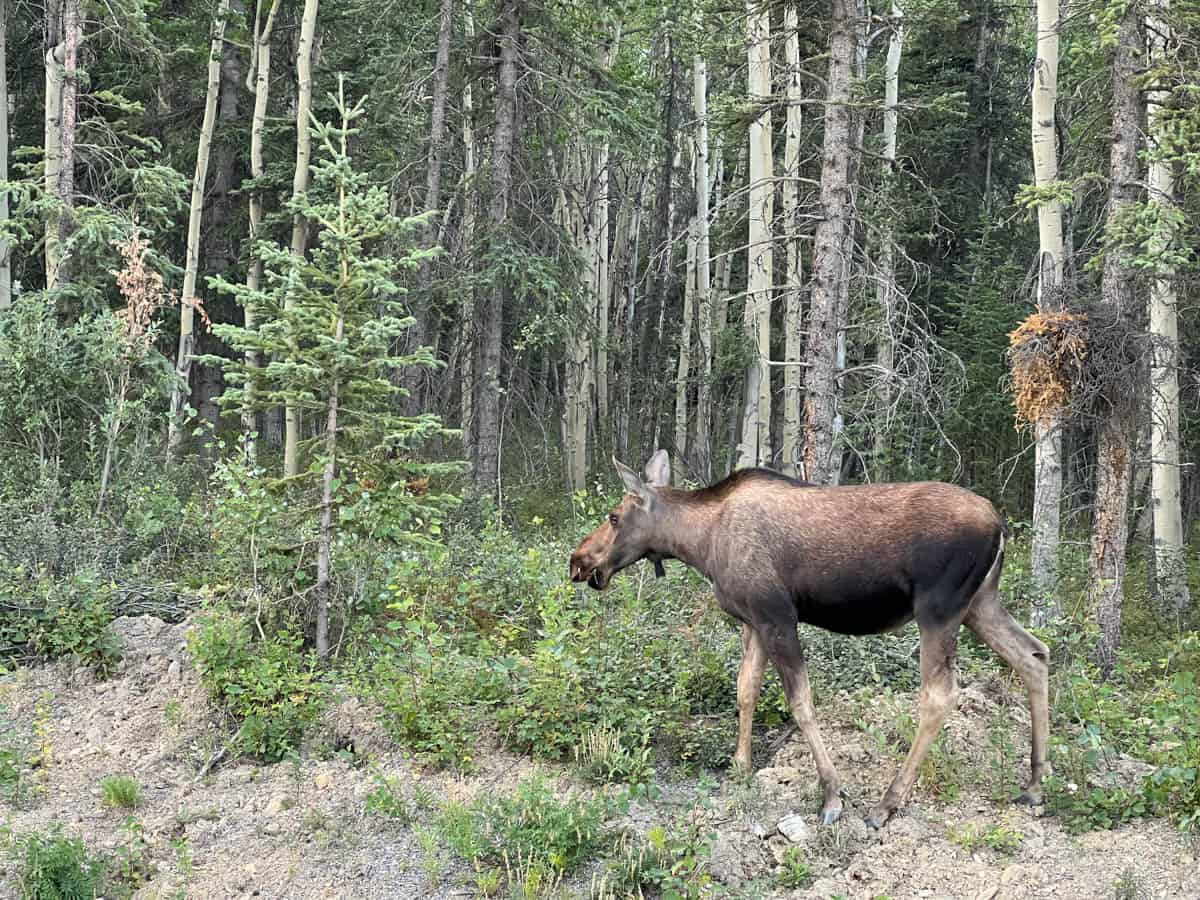
We made a video of our trip that highlights our time in Denali National Park if you want to check it out!
More Alaska Travel Posts
Planning a trip to Alaska? Be sure to check out some of our other Alaska travel guides.
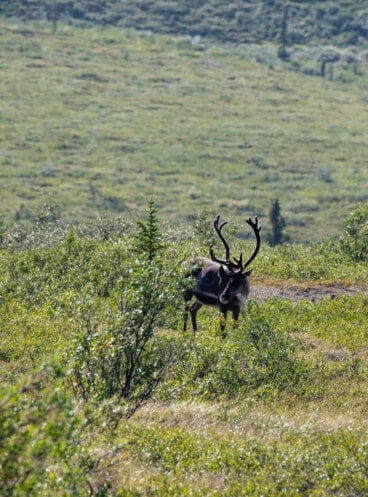
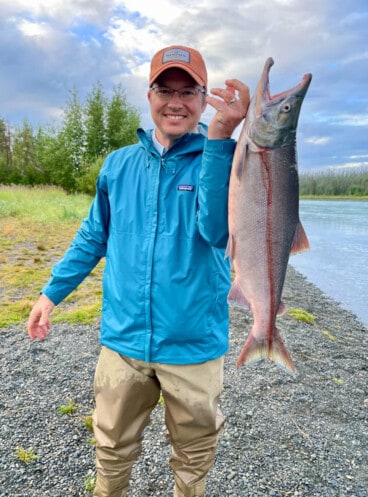
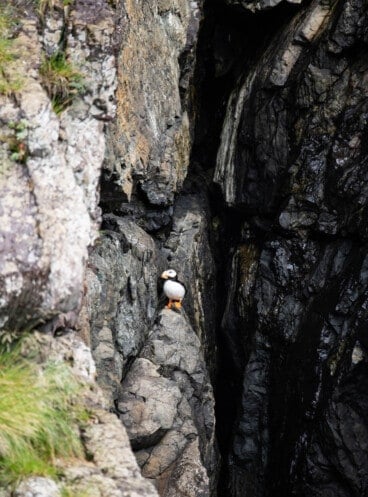

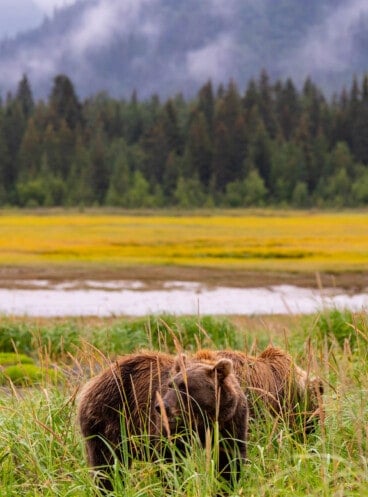

Great article, we are going on an Alaska cruise, hope we get to see it, we’re going end of July.
Oh wow you are going to have a great time! Alaska is just so beautiful!